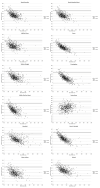Accuracy of the Resting Energy Expenditure Estimation Equations for Healthy Women - PubMed (original) (raw)
Accuracy of the Resting Energy Expenditure Estimation Equations for Healthy Women
Rafael Molina-Luque et al. Nutrients. 2021.
Abstract
Background: There exist several prediction equations for the estimation of resting energy expenditure (REE). However, none of these equations have been validated in the Chilean female population yet. The aims of this study are (1) to determine the accuracy of existing equations for prediction of REE and (2) to develop new equations in a sample of healthy Chilean women.
Methods: A cross-sectional descriptive study was carried out on 620 Chilean women. The sample showed an age range between 18 and 73 years, a body mass index average of 28.5 ± 5.2 kg/m2, and a prevalence of overweight and obesity of 41% and 33.2%, respectively. REE was measured by indirect calorimetry (REEIC), which was used as the gold standard to determine the accuracy of twelve available REE prediction equations and to calculate alternative formulas for estimation of REE. Paired t-tests and Bland-Altman plots were used to know the accuracy of the estimation equations with REEIC. At the same time, multiple linear regressions were performed to propose possible alternative equations. The analyses were carried out by age groups and according to nutritional status.
Results: All the equations showed a tendency to overestimate REE, regardless of age or nutritional status. Overall, the Ireton-Jones equation achieved the highest mean percentage difference from REEIC at 67.1 ± 31%. The alternative new equations, containing variables of body composition, reached a higher percentage of classification within ± 10% of REEIC.
Conclusions: The available equations do not adequately estimate REE in this sample of Chilean women. Although they must be validated, the new formulas proposed show better adaptation to this Chilean sample.
Keywords: anthropometry; resting energy expenditure; women.
Conflict of interest statement
The author(s) declare that they have no conflict of interests.
Figures
Figure 1
Bland–Altman graphs for resting energy expenditure equations using indirect calorimetry as the gold standard.
Similar articles
- Low validity of predictive equations for calculating resting energy expenditure in overweight and obese women with polycystic ovary syndrome.
Rodrigues AMDS, Costa ABP, Campos DL, Silva MPS, Cândido AL, Santos LCD, Ferreira AVM. Rodrigues AMDS, et al. J Hum Nutr Diet. 2018 Apr;31(2):266-275. doi: 10.1111/jhn.12498. Epub 2017 Aug 8. J Hum Nutr Diet. 2018. PMID: 28791776 - Measurement of resting energy expenditure and its accuracy in women with breast cancer.
Cioffi I, Di Vincenzo O, Morlino D, Ramos da Silva B, Prado CM, Santarpia L, Scalfi L, Giuliano M, De Angelis C, Pasanisi F, Arpino G, Marra M. Cioffi I, et al. Clin Nutr. 2024 Nov;43(11):54-64. doi: 10.1016/j.clnu.2024.09.037. Epub 2024 Sep 25. Clin Nutr. 2024. PMID: 39342800 - Validating an energy expenditure prediction equation in overweight and obese Mexican patients.
Quiroz-Olguín G, Serralde-Zúñiga AE, Saldaña-Morales MV, Gulias-Herrero A, Guevara-Cruz M. Quiroz-Olguín G, et al. Nutr Hosp. 2014 Oct 1;30(4):749-55. doi: 10.3305/nh.2014.30.4.7639. Nutr Hosp. 2014. PMID: 25335657 - Estimation of energy expenditure using prediction equations in overweight and obese adults: a systematic review.
Madden AM, Mulrooney HM, Shah S. Madden AM, et al. J Hum Nutr Diet. 2016 Aug;29(4):458-76. doi: 10.1111/jhn.12355. Epub 2016 Feb 29. J Hum Nutr Diet. 2016. PMID: 26923904 Review. - Predictive equations for energy expenditure in adult humans: From resting to free-living conditions.
Fernández-Verdejo R, Galgani JE. Fernández-Verdejo R, et al. Obesity (Silver Spring). 2022 Aug;30(8):1537-1548. doi: 10.1002/oby.23469. Epub 2022 Jul 19. Obesity (Silver Spring). 2022. PMID: 35854398 Review.
Cited by
- A Systematic Review of Literature on the Representation of Racial and Ethnic Minority Groups in Clinical Nutrition Interventions.
Dhillon J, Jacobs AG, Ortiz S, Diaz Rios LK. Dhillon J, et al. Adv Nutr. 2022 Oct 2;13(5):1505-1528. doi: 10.1093/advances/nmac002. Adv Nutr. 2022. PMID: 35108358 Free PMC article. - Revised Harris-Benedict Equation: New Human Resting Metabolic Rate Equation.
Pavlidou E, Papadopoulou SK, Seroglou K, Giaginis C. Pavlidou E, et al. Metabolites. 2023 Jan 28;13(2):189. doi: 10.3390/metabo13020189. Metabolites. 2023. PMID: 36837808 Free PMC article. - Modeling Energy Expenditure Estimation in Occupational Context by Actigraphy: A Multi Regression Mixed-Effects Model.
Lucena A, Guedes J, Vaz M, Silva L, Bustos D, Souza E. Lucena A, et al. Int J Environ Res Public Health. 2021 Oct 3;18(19):10419. doi: 10.3390/ijerph181910419. Int J Environ Res Public Health. 2021. PMID: 34639718 Free PMC article.
References
- Organización Mundial de la Salud Noncommunicable Diseases. [(accessed on 30 May 2020)]; Available online: https://www.who.int/news-room/fact-sheets/detail/noncommunicable-diseases.
- Bennett J.E., Stevens G.A., Mathers C.D., Bonita R., Rehm J., Kruk M.E., Riley L.M., Dain K., Kengne A.P., Chalkidou K., et al. NCD Countdown 2030: Worldwide trends in non-communicable disease mortality and progress towards Sustainable Development Goal target 3.4. Lancet. 2018;392:1072–1088. doi: 10.1016/S0140-6736(18)31992-5. - DOI - PubMed
- Forouzanfar M.H., Afshin A., Alexander L.T., Anderson H.R., Bhutta Z.A., Biryukov S., Brauer M., Burnett R., Cercy K., Charlson F.J., et al. Global, regional, and national comparative risk assessment of 79 behavioural, environmental and occupational, and metabolic risks or clusters of risks, 1990–2015: A systematic analysis for the Global Burden of Disease Study 2015. Lancet. 2016;388:1659–1724. doi: 10.1016/S0140-6736(16)31679-8. - DOI - PMC - PubMed
- Yusuf S., Joseph P., Rangarajan S., Islam S., Mente A., Hystad P., Brauer M., Kutty V.R., Gupta R., Wielgosz A., et al. Modifiable risk factors, cardiovascular disease, and mortality in 155,722 individuals from 21 high-income, middle-income, and low-income countries (PURE): A prospective cohort study. Lancet. 2020;395:795–808. doi: 10.1016/S0140-6736(19)32008-2. - DOI - PMC - PubMed
MeSH terms
LinkOut - more resources
Full Text Sources
Other Literature Sources
